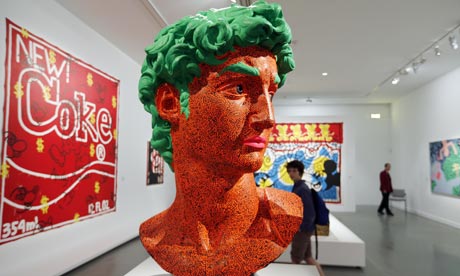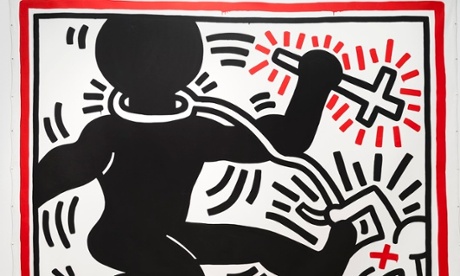In the summer of 1986 Keith Haring, 28, travelled from Milan, where he took part in a public presentation of one of his projects in aid of children, and then on to Tokyo, for another project. He had come to international notice four years earlier, when he was invited to take part in the Documenta show in Kassel, Germany, an exceptional honour for someone so young. During the long flight to Japan he noted his doubts in his diary. In Milan, the sponsors had hogged the limelight and Haring was unhappy about this "commercial" intrusion. Despite this, he was convinced that with time people would understand his approach to being a contemporary artist.
We finally seem to have reached that point. Haring died of Aids in 1990. The retrospective staged by the Musée d'Art Moderne in Paris is the first to focus on the artist's political commitment. It aims to present Haring as he wanted to be seen and understood, a daunting task given his prolific output. Indeed the show, which features almost 250 works including large-scale pieces, spills over into the Centquatre, the only public hall able to accommodate them. Another difficulty is that Haring worked in public places – New York subway stations, billboards and outdoor spaces. This was at the heart of his political approach to art, unusual at a time when most of his contemporaries had turned away from such an engagement.
In 1980 he posted simple collages in New York made from press photographs and messages cut from newspaper headlines, such as "Reagan: ready to kill" or "Reagan slain by hero cop". Such provocative montages mocked newspaper headlines and formed an off-beat commentary on local and international news. Drawn in white chalk or black paint on billboards that hung alongside an advert for, say, Penthouse magazine or a film poster, Haring's work would be seen by the general public. His fragile and hasty creations were a counter to the medium of mass communication.
As his fame grew, Haring and his assistants started producing ever bigger friezes displayed beside New York highways or on university campuses. He accepted commissions for public health campaigns in New York and Barcelona, against nuclear proliferation and against apartheid in South Africa. His was a rationale of intervention, underground in his early work, but soon accepted by the establishment and sought after.
Haring's diary explains the methods for his visual strategy of invading the city. Haring's model for this was Andy Warhol . "He was the first real public artist," he wrote in 1987, the year Warhol died. "I honestly think he was the most important artist since Picasso, whether people like it or not, and a lot of them don't."
Behind this conception of the artist-activist lay Haring's exceptional gift for drawing, which was apparent from childhood. At 18 he enrolled at Pittsburgh's Ivy School of Art. However, rather than academic work, what is abundantly clear in the first room of the exhibition is Haring's fanatical, voluptuous love of drawing. For example, in 1978 with the aim of producing his Manhattan Penis Drawings as fast as possible for sites such as opposite Tiffany's or the Museum of Modern Art, he invented simple, efficient signs, but never repeated the same composition.
His method was to devise pictograms that could be drawn preferably in a single continuous brush stroke. These signs were abbreviations for a human body, a monkey, a hand, a phallus, a caterpillar or a plane. He associated them with geometrical symbols – crosses, spirals, waves and parallel streaks.
When they multiply you have to stand back to distinguish the figurative shapes among the mass of abstract signs. This vocabulary borrows widely, from Aboriginal art to railway signs. Haring was also well acquainted with Picasso, Klee and Dubuffet.
Haring rarely uses these signs individually. They mingle, making up scenes and narratives that enable the artist to deploy his political symbolism. Signs are enslaved, chased by police tracker dogs, standing dazed before monkey gods, or sick, dying of Aids. Our initial response to these hieroglyphs of oppression, desire or death may be to admire the prodigious skill with which he produced them. But a much less artistic response follows, emotional, moral or political. Haring has achieved his aim.
Keith Haring, the Political Line is at the Musée d'Art Moderne in Paris until 18 August
• This article appeared in Guardian Weekly, which incorporates material from Le Monde









